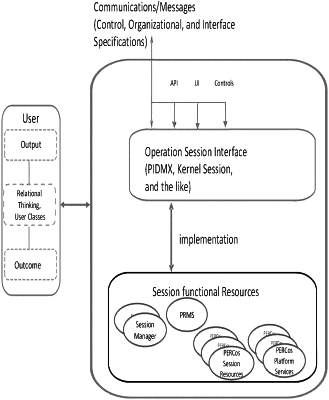| CPC G06F 9/50 (2013.01) [G06F 9/5072 (2013.01); G06F 9/5083 (2013.01); G06F 16/245 (2019.01); G06F 16/248 (2019.01); G06F 16/24575 (2019.01); G06F 16/285 (2019.01); G06F 40/00 (2020.01); G06Q 10/0631 (2013.01); H04L 47/70 (2013.01); G06F 16/9535 (2019.01); G06F 21/31 (2013.01); G06F 2221/2141 (2013.01); G06Q 50/01 (2013.01); H04L 63/10 (2013.01); H04L 63/101 (2013.01); H04L 63/20 (2013.01)] | 30 Claims |

|
1. A system for enabling provision of a secure and reliable user and computing arrangement interface framework optimized for computing arrangement resource identification, suitability, and/or selection, the system including:
a hardware and software computing arrangement, comprising at least one hardware processor, at least one memory, and at least one communication means, for use in providing at least in part standardized one or more resources and/or specifications that enable:
using a tamper resistant sensor arrangement to biometrically identify at least one human stakeholder of a resource;
configuring at least one user interface arrangement to enable users to specify their respective expressions of approximate computing arrangement usage objectives, wherein
the expressions of approximate computing arrangement usage objectives employ user purpose classes as conceptual units of respective user generated queries, wherein:
(a) the queries are specified for computing resource identification, evaluation, and/or selection, and
(b) verb and category tokens, selected from respective expression approximation ref/sense token groups are respectively employed in user expressions of such user purpose classes;
providing expression approximation edge classes for communication between users and their respective computing resource identification, evaluation, and/or selection, computing arrangements, such communication of approximations occurring across edge boundaries between users using user purpose classes and such users' respective computing arrangements, such communications using respective user computing arrangements' cross-edge operations, wherein:
(a) such computing arrangements' cross-edge operations enable identification of internal classes that respectively optimize the approximation of computing arrangement usage objectives, wherein such operations include:
(i) processing user purpose classes to respectively identify previously declared edge classes that correspond to conceptual units of such user purpose classes, wherein the identification is, at least in part, based upon user class conceptual unit expressions', and edge class concept approximating, declared ref/sense token groups', approximate meaning correspondence, wherein:
(1) the previously declared edge classes are at least in part user interpretable and stable over time to enable consistent identification of internal classes, and
(2) each edge class concept approximating, declared ref/sense token group comprises one or more tokens that comprise a corresponding operatively synonymous approximate representation of at least one user class conceptual unit, and
(ii) communicating one or more such identified, previously declared edge classes to an analytic arrangement, and
(b) such edge classes are configured employing edge class concept approximating, declared ref/sense token groups of word sets, wherein the word sets in each edge class concept approximating declared ref/sense token group are treated as having the same arrangement approximate meaning;
providing an analytic arrangement to identify computer internal classes that approximately correspond to such communicated, identified previously declared edge classes, wherein:
(a) such identification is based, at least in part, on producing standardized, computing arrangement internally consistent and reproducible information results, and
(b) the internal classes are: (i) stable over time to optimize hardware processing performance, and (ii) configured to improve computer information processing management efficiency and/or outcome, logical reasoning, searching, matching, and/or other internal computing arrangement processing;
associating the resource stakeholder's biometric identification information with factual, testable attribute information of such stakeholder;
securely governing such associated factual, testable resource stakeholder attribute information through use of tamper resistant hardware processing and memory; and
using the stakeholder's biometric identification, and factual, testable attribute, information in the identification, evaluation, and/or selection of a resource.
|